The title of this edition of Feathered Photography could also be “The Peregrine Falcon and the Frozen Coot – Part 2” because it’s a continuation of my post three days ago about the female Peregrine Falcon feeding on a frozen coot.
This part of my encounter with the falcon gave me a feeling for how a doomed duck must feel an instant before it meets its violent demise.
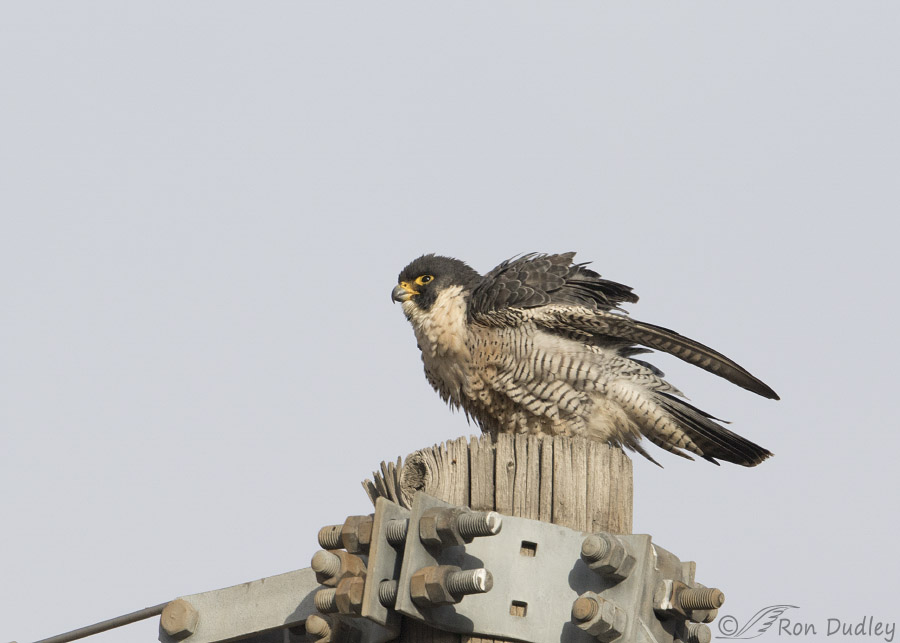
1/2500. f/7.1, ISO 500, Canon 7D Mark II, Canon EF 500mm f/4L IS II USM + EF 1.4 III Extender, not baited, set up or called in
When the falcon finished her meal of frozen coot she took off and landed on top of this power pole where she cleaned off her beak, did a little scratching and grooming and then roused.
- I was disappointed that soon after she landed here bright clouds moved in behind her which made for a background that I don’t like (and as you’ll see it only gets worse). High-key backgrounds have never appealed to me much, partly because they tend to wash out the subject but in this case I just had to live with it. But this post is more about my experience with the falcon than it is the quality of the images.
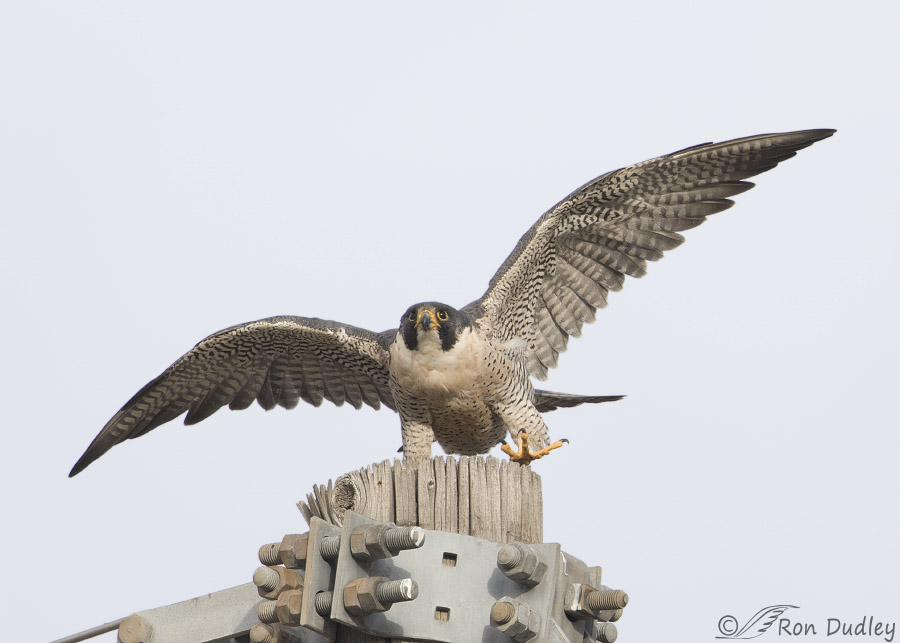
1/800. f/6.3, ISO 500, Canon 7D Mark II, Canon EF 500mm f/4L IS II USM + EF 1.4 III Extender, not baited, set up or called in
After grooming and resting for some time she spread her wings and then held them in that position for an extended period as she turned to face my direction (I’m in my pickup far below the tall pole).
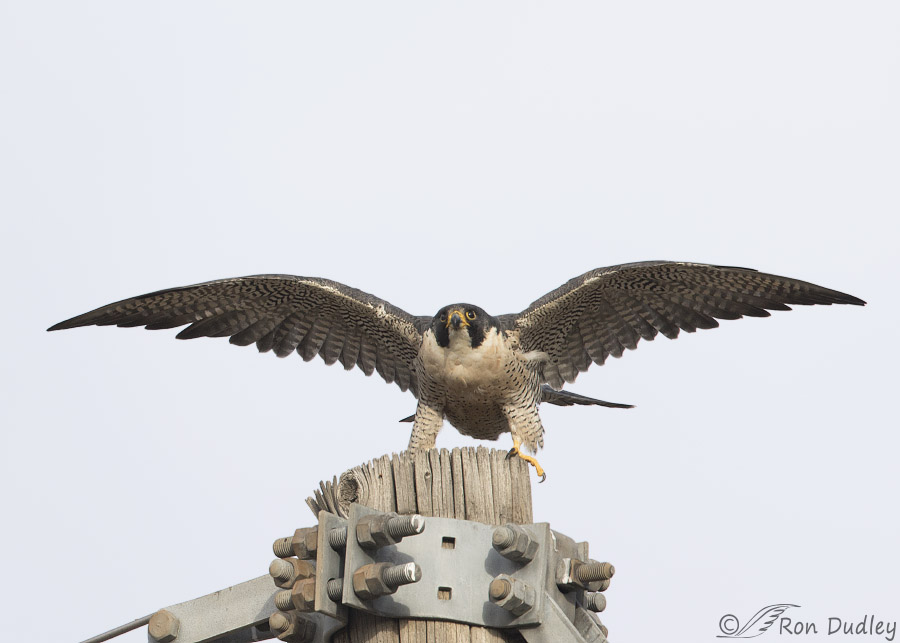
1/1250. f/6.3, ISO 500, Canon 7D Mark II, Canon EF 500mm f/4L IS II USM + EF 1.4 III Extender, not baited, set up or called in
She held her wings out for so long I was able to take 20 photos of her with them spread like this. In most of them (including the two above) she was looking above and past me. However just before she took off she…
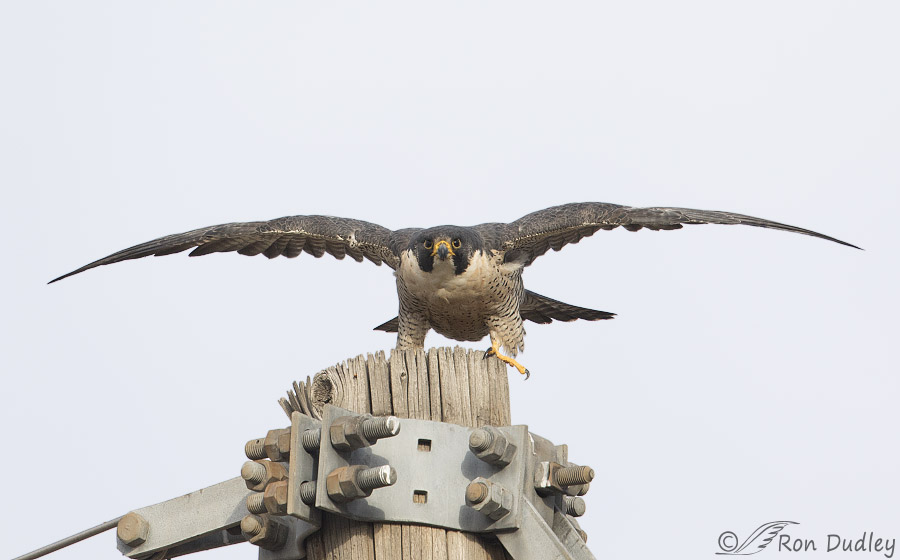
1/1000. f/6.3, ISO 500, Canon 7D Mark II, Canon EF 500mm f/4L IS II USM + EF 1.4 III Extender, not baited, set up or called in
locked her focus on me like radar and she kept me in her crosshairs for the entire episode that follows.
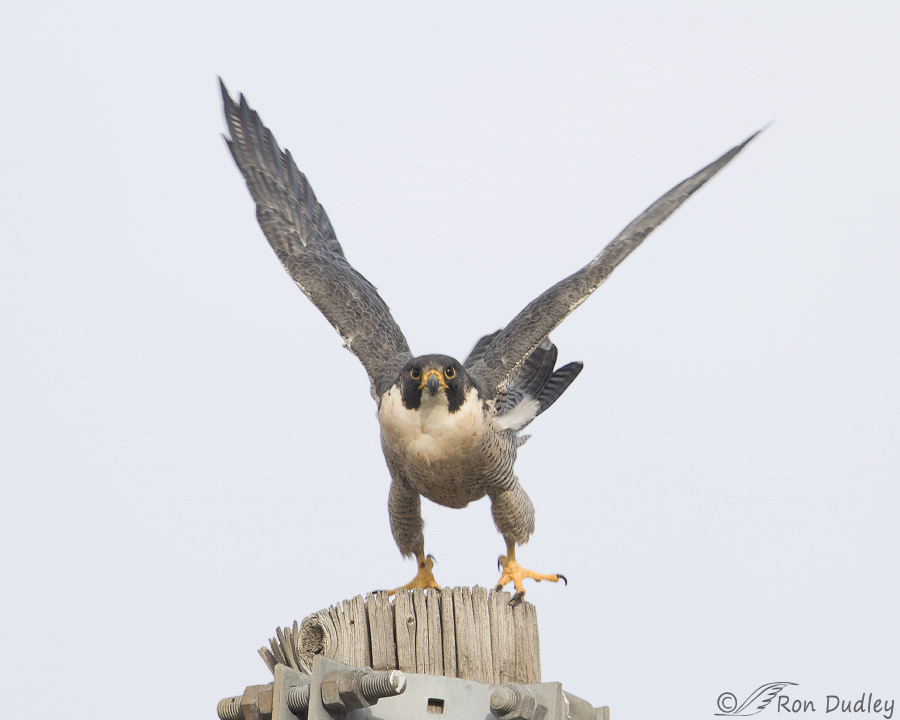
1/800. f/6.3, ISO 500, Canon 7D Mark II, Canon EF 500mm f/4L IS II USM + EF 1.4 III Extender, not baited, set up or called in
Then she raised her wings further and…
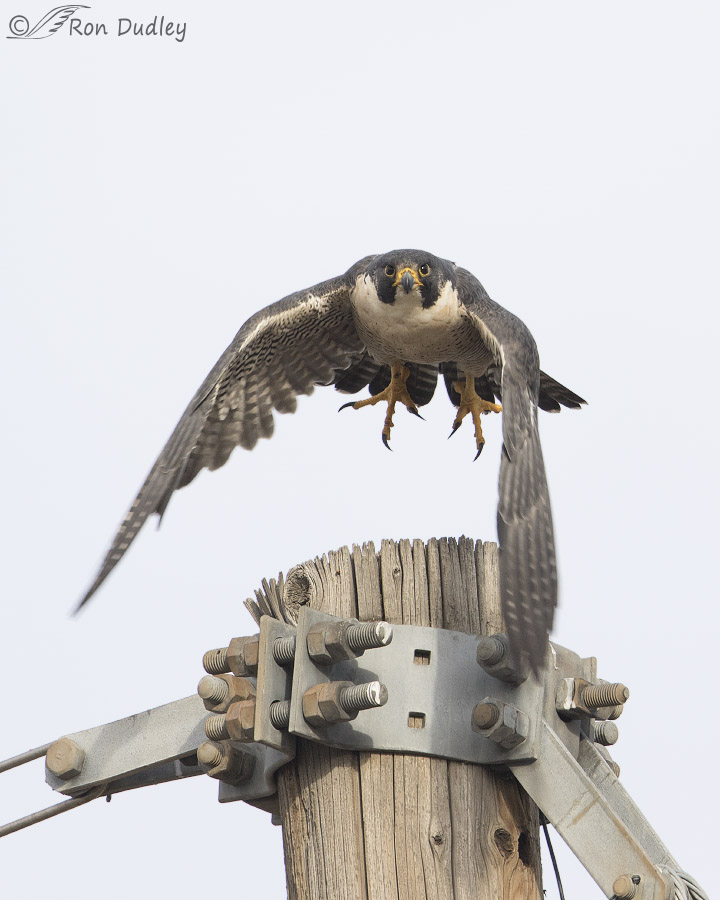
1/800. f/6.3, ISO 500, Canon 7D Mark II, Canon EF 500mm f/4L IS II USM + EF 1.4 III Extender, not baited, set up or called in
launched directly at me.
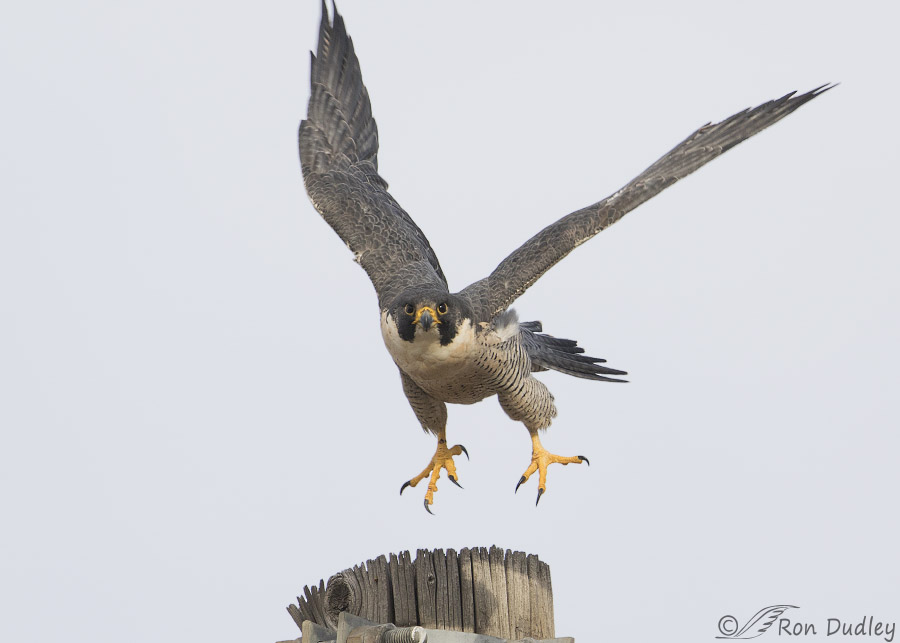
1/1000. f/6.3, ISO 500, Canon 7D Mark II, Canon EF 500mm f/4L IS II USM + EF 1.4 III Extender, not baited, set up or called in
I had to wonder if I was about to become her next target because…
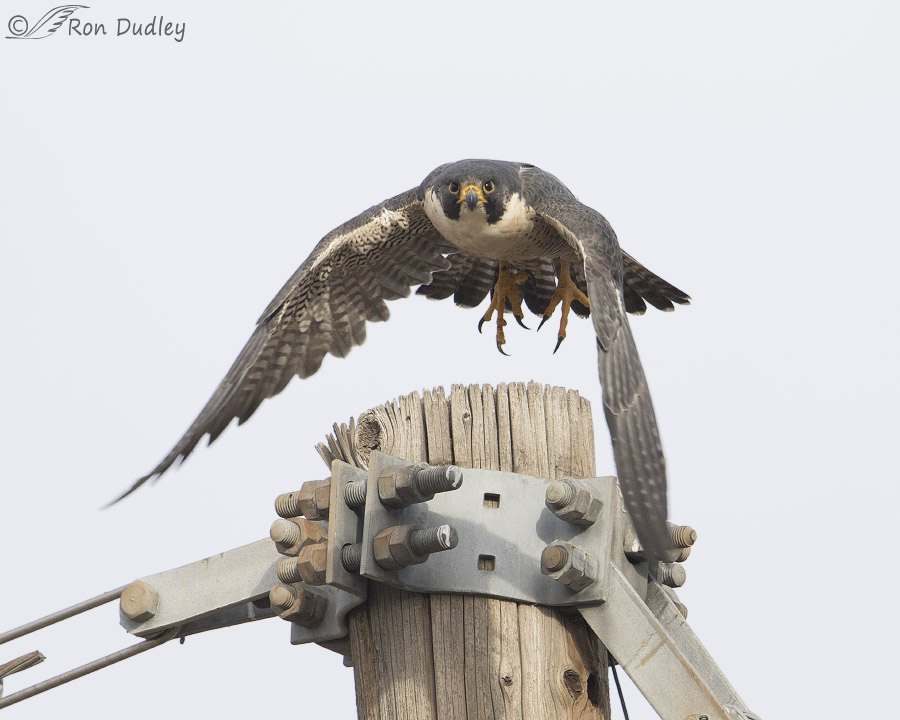
1/1000. f/6.3, ISO 500, Canon 7D Mark II, Canon EF 500mm f/4L IS II USM + EF 1.4 III Extender, not baited, set up or called in
she was so intensely focused on me as she…
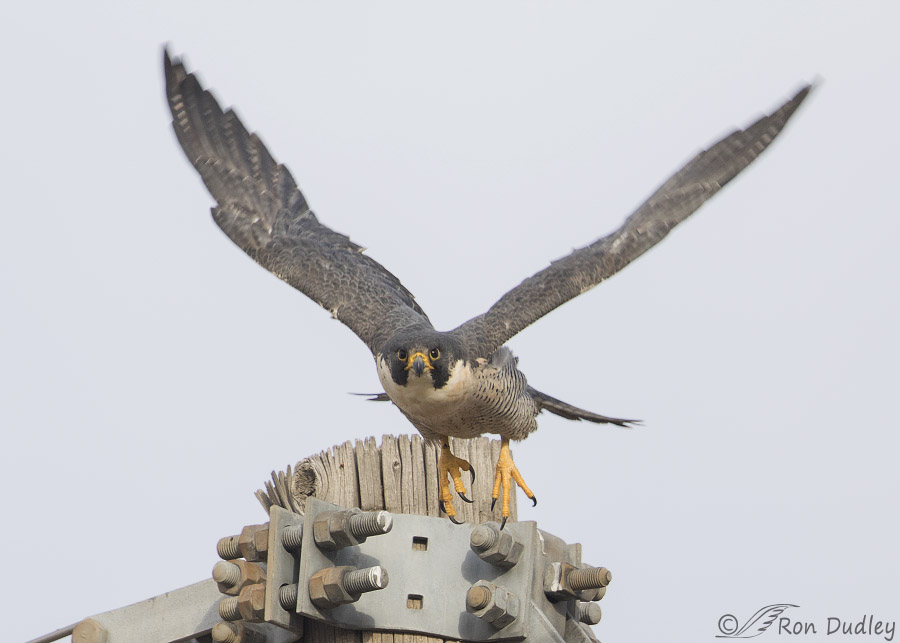
1/1000. f/6.3, ISO 500, Canon 7D Mark II, Canon EF 500mm f/4L IS II USM + EF 1.4 III Extender, not baited, set up or called in
accelerated in my direction (just look at the size of those menacing feet and talons!).
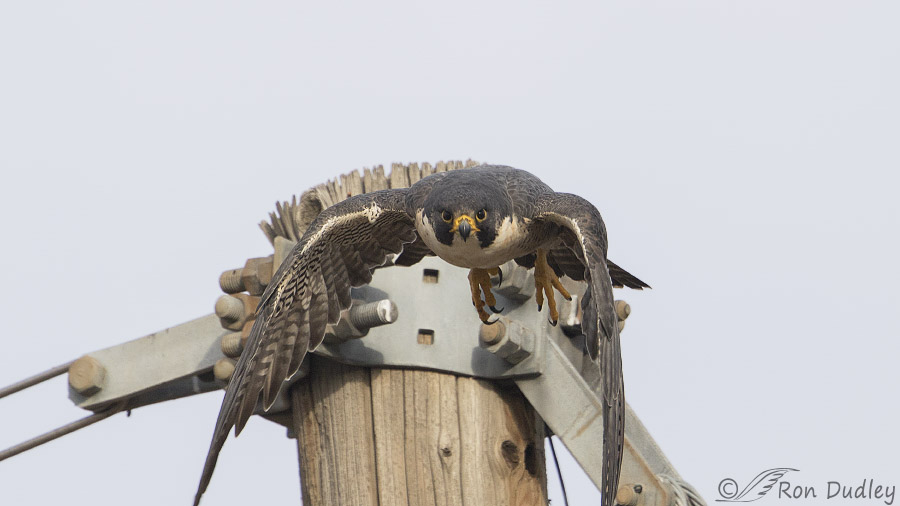
1/1250. f/6.3, ISO 500, Canon 7D Mark II, Canon EF 500mm f/4L IS II USM + EF 1.4 III Extender, not baited, set up or called in
Naturally as she unexpectedly closed in on me I began to clip and cut off body parts…
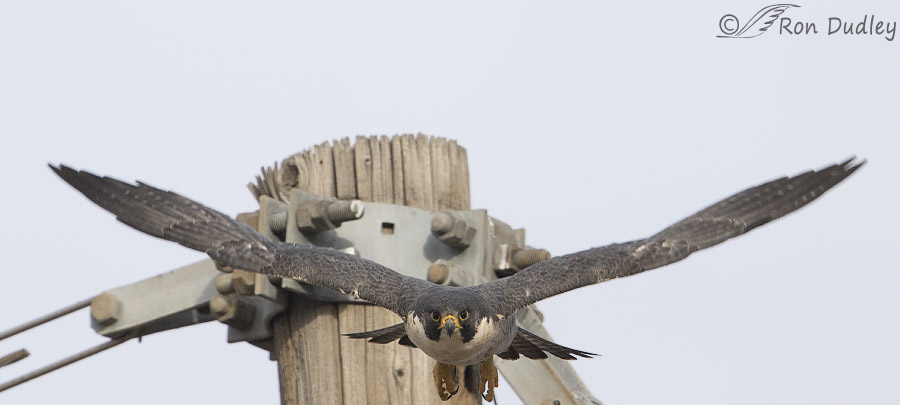
1/1600. f/6.3, ISO 500, Canon 7D Mark II, Canon EF 500mm f/4L IS II USM + EF 1.4 III Extender, not baited, set up or called in
but I continued my burst anyway to see what I might get.
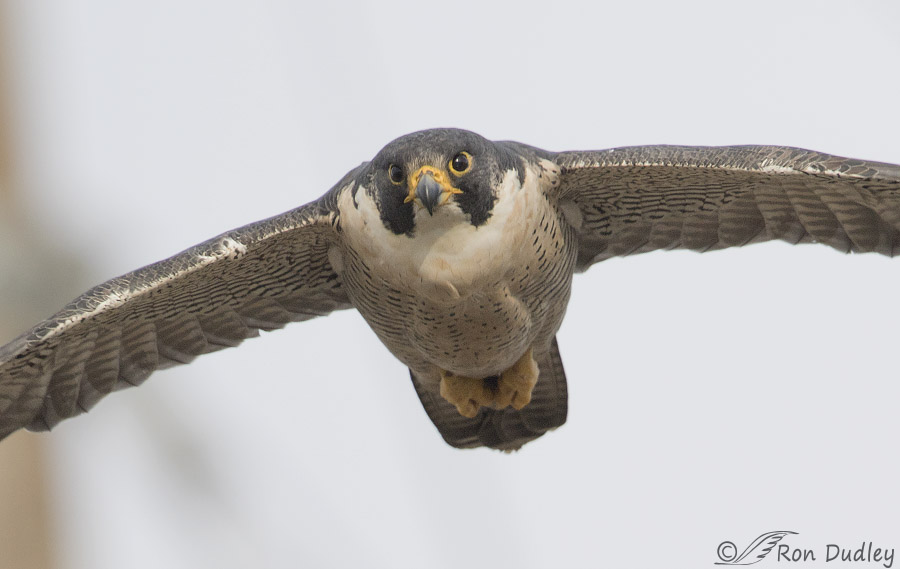
1/1600. f/6.3, ISO 500, Canon 7D Mark II, Canon EF 500mm f/4L IS II USM + EF 1.4 III Extender, not baited, set up or called in
This is the last fairly sharp shot I got as she passed close over the top of my pickup, circled around and then landed on top of another nearby pole.
I’m not sure what her intention was when she flew at me. Perhaps she was only curious about us and/or my pickup but with her incredible eyesight I’m sure she already knew everything she needed to about us – after all I’d just spent 55 minutes with her as she fed on the coot and then rested on the pole.
I’m more inclined to believe she was trying to intimidate me. Peregrines are known for their aggressive, even confrontational nature toward their own and some other species. This description of their bellicose nature with each other caught my eye (from Cornell’s Birds of North America Online).
- “Vicious and prolonged fights, sometimes lasting hours and resulting in fatal injuries if one bird does not break away soon enough”
So perhaps this bird thought of me as a potential competitor in her hunting territory and this had been an attempt to drive me away (and I did leave very soon after this event even though she was still on the second pole). During my entire time with her I had never noticed any behavioral sign of her being nervous or upset with my presence but of course I couldn’t read her mind.
Whatever her motivation it certainly got my attention.
Ron


This is an awesome series that were so enjoyable to see. Maybe it WAS looking into your lens like a mirror. I solve all the comments. linda
Ron,
Please tell me they fly away from you more often than towards you posing in such magnificence! I have more shots of birds’ tails than anything else, infinitely more than their gaze locked on me.
Stephen
Ron, this sequence is spectacular! In fact, may I ask to use it for educational outreach purposes? I am Lead of the Peregrine Team in Pine Canyon, an SF Bay Area all-vol group of naturalists. We help two local parks keep trespassers out of a PEFA nesting closure zone Feb 1-July 31 every year via education on the trail, in schools, and other public arenas. We would give you full credit, of course. I could Grab what I need. I wouldn’t have to trouble you to send me high res shots. We have a Facebook site that will allow you to take a quick look. It’s a closed site, but you can see the canyon where we work and read our mission statement. I’d make you an honorary member if you’d like!
Many thanks!
Hi Anastasia,
I’m familiar with “Diablo Canyon” because of an incredible experience I had with a young Prairie Falcon that was fledged there but I photographed it 6 weeks later in southwest Montana. I was able to read its band numbers and…. well, you can see the rest of the story from this link. I’ll bet you know Doug Bell, Wildlife Program Manager for East Bay Regional Park District out of Oakland.
https://www.featheredphotography.com/blog/2013/08/01/banded-prairie-falcon-update/
You have permission to use those images for your education program. I applaud your efforts. Please let me know if you also use any of them on your FB page. If you do I’ll ask to join the group so I can see them.
Wonderful post and I’m sure it was an even more wonderful experience. She’s beautiful and even though you are disappointed by some of the weather/lighting conditions, I think the images are beautiful!
There’s just something special about raptors. That intensity, power and sheer lethal beauty makes your heart flutter–or at least it should. If it doesn’t, you probably oughta check your pulse. And that’s exactly the addictive part of falconry. You get to see that intensity, power and sheer lethal beauty up close and personal almost every day. And when you do, you turn into a two-year-old, jumping and clapping, saying, “Do it again! Do it again!”
And when they’re coming right at you like this, that intensity, power and sheer lethal beauty lets you know that you are mortal, you are vulnerable to springing a huge, life-threatening leak (bloodletting) and you are NOT at the top of the food chain. Yes, I know you think you are at the top, but you just aren’t. And it’s good to know that.
Thank you SO much for standing in the face of that intensity and keeping your finger on the button!
As long as the bird is coming for you head first, there’s no need to worry. On the other hand if you see the feet swinging forward toward you…….well actually by then it’s too late to worry. What a beauty!
Cool! Computer did the blue screen this morning and we are both recovering from norovirus so it’s kindle for me and UGH! Don’t wish this on my worst enemy!
Damn, we call that the “blue screen of death”. I don’t wish it on (almost) anyone. Good luck, Judy!
Fortunately I’m backed up on an external drive ??
yep Fortunately I’m backed up on an external drive!?
Eeeesh! A couple of those shots gave me the shivers and goosebumps. I would hate to be on the receiving end of that gaze and those talons and beak. These are amazing shots!
Thank you, Marty.
Ron, what a series. Wish we knew what was in her mind. One of your reader’s articles about eyesight in birds/falcons is quite informative and makes you think that ‘your falcon’ saw something of extreme interest or threat. Glad you were in your pickup!!!
Alice, I plan to read that article when I get some important chores done. Haven’t yet, though…
How are you able to change settings on the fly against a moving target? I see your settings change from shot to shot.
Josh, my camera settings didn’t change after the second shot, only my shutter speed varied. That happens automatically with different lighting as my subject moves because I always shoot in aperture priority.
My aperture changed between the first and second shot because I had time to change it then. I made no adjustments while the bird was in flight.
That gaze puts a capital I in intense, and P in piercing doesn’t it?
Yet another amazing series.
Yes, it does both, EC. Thanks.
All I can say is WOW! Thank you!
Thanks, Pat.
Wow! What a way to start the day. As to Peregrines and their fierceness – there’s a video on youtube of a female Peregrine whose nest, with chicks, is on a cliff. A flock of brown pelicans flies by and she takes out two or three of them, with precision hits – grabbing the beak of one and literally flipping him out. Then she flies back to her nest ledge and grabs a huge snake and hauls it away from her chicks. Tiger Mom!
Lovely shots, Ron. Reminds me of why I love Peregrines. When they are in captivity, either as education or falconry birds, they are disappointing, at least to me. I have known a few and even had a small wingshot male for eight years, and while I loved him, it was plain he had had the spiritual stuffing knocked out of him. I feel something like that about Goshawks in captivity, too. Red-tails don’t seem to lose their moxie in captivity nearly as much. And Swainson’s Hawks seem to get more interesting the closer you get and the better you know them.
Very interesting observations about the attitudes of various raptor species in captivity, Sallie. Thanks very much for providing that info!
Thrilling sequence, Ron. It’s interesting to think about the eyes of this hawk – the bird can focus straight ahead and to either side, with two foveae per eye and much faster processing time than the human brain has. http://www.sfpinteractive.com/beyond-human-falcons/ It’s possible this bird was getting a full scan of you, your truck, and your gear. She’s better equipped than the NSA. . .;)
In re peregrine aggression – a few weeks ago a friend and I were at the ocean, at a beach backed with cliffs inhabited by peregrines and ravens. A peregrine took a surf scoter, and within 1 minute it was mobbed by turkey vultures, ravens, and crows, and the gang bang drove the peregrine away from its own kill. It sat on a driftwood log about 25 yards from its catch while the vultures, ravens, and crows disassembled the scoter and fought among themselves. We wondered aloud, amidst the white feathers scudding across the sand, if peregrines in general or this one in particular lack the software to defend their kill, or are at a disadvantage on the ground, or if this one just knew when she was outnumbered.
“She’s better equipped than the NSA”
You’re probably right about that, Martha. I like the way you put it.
Martha, from the ground, the peregrine doesn’t have its speed, which translates into its lethal power. In the air, she would rule the situation. Of course, that begs the question why she didn’t take to the air to defend her kill. In that situation, being outnumbered, the phrase that sometimes discretion is the better part of valor comes too mind.
Spectacular, Ron! Simply spectacular! Can’t wait until I get home and can view the series full-screen.☺
Full screen makes a big difference, Diane. Hope you enjoy them the second time around.
Another wow. You must have felt relieved when she retracted her landing gear in the last photo!
Kent, it all happened so fast I didn’t have time to feel any tension about it. I was just concentrating on getting the shots.
Wow. Just wow.
🙂
That’s a cool sequence of shots! I had the exact same experience with a snowy owl in 2017. It was about 90 yards away on a fence post. After watching it through the viewfinder from my Jeep, for 2 hours, it suddenly began bobbing it’s head, looking right at me. It launched and flew directly toward me (as I fired shots) until it was so close, I couldn’t focus. I’m estimating it flew within 10 feet of me, before veering off and landing on a piece of farm equipment about 30 feet away. My theory was that it was watching its reflection in my lens glass. Maybe that’s what your falcon was doing? I’ll never know if that’s true, but that’s my story and I’m sticking with it. Whatever the reason, it was the best experience and best photos I’ve ever taken of a snowy owl in flight.
What happened with your owl sounds very similar to what happened with this falcon, Everet. It sure would be interesting to know for sure what was going on in both instances.
I like the photos and the story that goes with it. Always fun to see a PEFA coming right at ya’!
Thanks, Zaph. Yes, it certainly is.
Intense!!!
Yup.
“gave me a feeling for how a doomed duck must feel” Isn’t it fortunate you aren’t a duck! You obviously understand the fear and trepidation prey items have when they at the last moment see a master predator coming at them! What a great set of shots, glad you kept clicking away. Every time I see those talons I’m awed, such a lethal, powerful bird.
Dick, I’ll never forget watching a Shoveler on the water being struck by a Prairie Falcon a few years ago. In that case I don’t believe the duck even saw the falcon coming, or if it did it had no time to react. That one raking from the falcons talons caused immediate spurting of blood and the duck died on the water within seconds.
Wow! That’s an amazing sequence. If birds thought like people, I would say she wanted you to show the world know that she is a fierce and powerful being! And beautiful. She is beautiful.
Yes, she is a stunning bird, Kathleen. And she certainly wasn’t intimidated by me, that’s for sure.
Yow ! How far away was she from you when she finally tucked her talons ? It certainly appeared as if she was “going for it”……..
Kris, I could only guess at that distance but she was quite close.